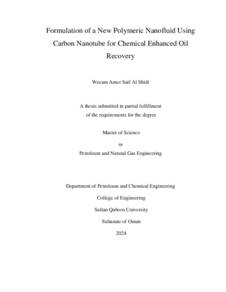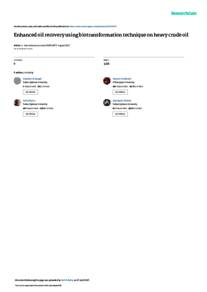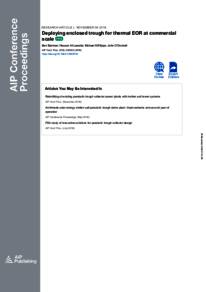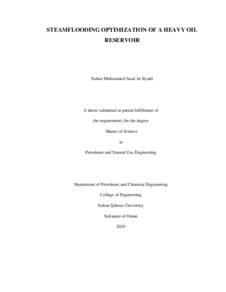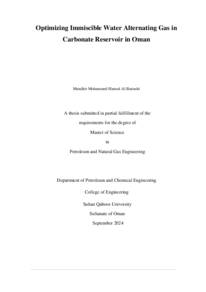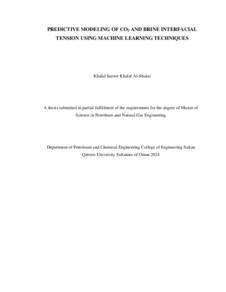Document
Formulation of a new polymeric nanofluid using carbon nanotube for chemical enhanced oil recovery.
Source
Master's thesis
Country
Oman
City
Muscat
Publisher
Sultan Qaboos University
Gregorian
2024
Language
English
Thesis Type
Master's thesis
English abstract
Enhancing oil recovery (EOR) using a polymer is commonly used as a tertiary recovery to
enhance the production of oil felids that have reached depletion in oil production. It is known
that the sensitivity of the polymer in the harsh environment of the reservoir due to the high
salinity and high temperature weakens the performance of the polymer in EOR such as poor
injectivity, poor sweep efficiency, and gravity override. However, Nanotechnology could be
one of the new techniques that help to overcome the challenges that face the polymer in
CEOR. This study evaluated new aqueous polymeric nanofluid to investigate how effectively
it performed when exposed to different temperatures, salinities, and aging times to improve the
performance of chemical EOR. The polymer used in this study was HPAM with a hydrolysis
level of 40% and a molecular weight of 10 MD. This study's objectives are to improve the
performance of a polymer HPAM by upgrading rheological characteristics using a multi-walled
carbon nanotube functionalized with -COOH (MWCNT-COOH). Synthesized polymeric
nanofluid and its performance will be evaluated through several temperatures and salinities.
The Polymeric nanofluids will be characterized by using the subsequent methods. First, to
detect the bonding of the polymeric nanofluid, the FTIR (Fourier Transform Infrared
spectrometer) test will be performed. Then, to study the viscoelastic behavior of polymeric
fluids, which is the most essential property, both static and dynamic shear rate conditions will
be employed. After that, the interfacial tension between oil and a new polymeric nanofluid at
different concentrations and temperatures will be determined using the spinning drop
technique. Additionally, wettability alteration behavior will be studied using contact angle (θ)
measurements of polymeric fluid on an oil-saturated sandstone surface. Finally, core flooding
experiments will be conducted to analyze and compare the ability of novel nano polymeric
composites versus conventional polymers in oil recovery under reservoir conditions. The study
showed that the optimized polymeric nanoparticle injection increased the recovery factor by 10
%. These findings the use of polymeric nanofluids could be a promising methodology to
enhance oil recovery in harsh oil recovery in harsh environments with high temperatures and
salinity. By addressing the limitations of polymer flooding and improving the performance of
chemical EOR, the application of polymeric nanofluids has the potential to maximize oil
production in reservoirs.
Arabic abstract
يُستخدم عادةً تعزيز استخلاص النفط باستخدام البوليمر كاستخلاص ثالثي لتعزيز إنتاج حقول النفط التي وصلت إلى مرحلة النضوب في إنتاج النفط. ومن المعروف أن حساسية البوليمر في البيئة القاسية للمكمن بسبب الملوحة العالية ودرجة الحرارة المرتفعة تضعف أداء البوليمر في الاستخلاص المعزز للنفط مثل ضعف الحقن وضعف كفاءة المسح وتجاوز الجاذبية. ومع ذلك، يمكن أن تكون تقنية النانو إحدى التقنيات الجديدة التي تساعد في التغلب على التحديات التي تواجه البوليمر في عملية الاستخلاص المعزز للنفط. قامت هذه الدراسة بتقييم السائل النانوي البوليمري المائي الجديد لمعرفة مدى فعاليته عند تعرضه لدرجات حرارة وملوحة من أجل تحسين أداء الاستخلاص المعزز للنفط الكيميائي. البوليمر المستخدم في هذه الدراسة هو البولي أكريليمايد بمستوى تحلل مائي %40 ووزن جزيئي 10 ملي جرام. تهدف هذه الدراسة إلى تحسين أداء البوليمر من خلال تحسين الخصائص اللزوجة باستخدام أنابيب نانوية كربونية متعددة الجدران. سيتم تقييم السائل النانوي البوليمري المركب وأدائه من خلال درجات حرارة وملوحة متعددة. سيتم في هذه الدراسة توصيف الموائع النانوية البوليمرية باستخدام الطرق الالحقة. أولاً للكشف عن ترابط السائل النانوي البوليمري، سيتم إجراء اختبار )مطياف الأشعة تحت الحمراء لتحويل فورييه(. بعد ذلك، لدراسة السلوك اللزوج ة المرنه للسوائل البوليمرية، والتي تعد الخاصية الاكثر أهمية، سيتم استخدام ظروف معدل القص الساكن والديناميكي. بعد ذلك، سيتم تحديد التوتر السطحي بين الزيت والسوائل النانوية البوليمرية الجديدة بتركيزات ودرجات حرارة مختلفة باستخدام تقنية السقوط الدوار. بالاضافة إلى ذلك، سيتم دراسة سلوك تغيير قابلية البلل باستخدام قياسات زاوية الاتصال للسائل البوليمري على سطح الحجر الرملي المشبع بالنفط. وأخيرا تجارب الغمر ،ً سيتم إجراء الاساسية لتحليل ومقارنة قدرة المركبات البوليمرية النانوية الجديدة مقابل البوليمرات التقليدية في استخالص النفط في ظل ظروف المكامن. وأظهرت الدراسة أن حقن الجسيمات البوليمرية النانوية الامثل أدى إلى زيادة عامل الاسترداد بنسبة 10 .% تشير هذه النتائج إلى أن استخدام السوائل النانوية البوليمرية يمكن أن يكون منهجية واعدة لتعزيز استخلاص النفط في الاستخلاص القاسي للنفط في البيئات القاسية ذات درجات الحرارة المرتفعة والملوحة. من خالل معالجة القيود المفروضة على غمر البوليمر وتحسين أداء الاستخلاص المعزز للنفط الكيميائي، فإن تطبيق السوائل النانوية البوليمرية يبذل جهودًا محتملة لزيادة إنتاج النفط في الخزان إلى الحد الاقصى.
Category
Theses and Dissertations

